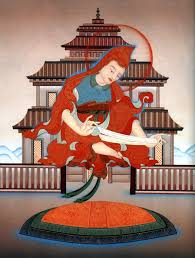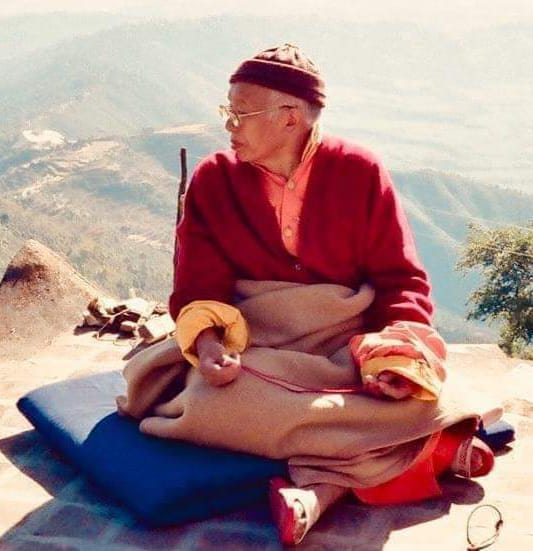Ārya Nāgārjuna: The Fundamental Wisdom of the Middle Way – Root Stanzas on the Middle Way, Sanskrit: Mula madhyamaka karika. Continue reading
Category Archives: Wisdom EN
Shantideva: Engaging in Bodhisattva Behavior – Bodhisattvacharyavatara

Shantideva: May no limited being ever have pain, Nor act with negative force, nor be sick, Nor be frightened, nor be derided, Nor ever be depressed.
Engaging in Bodhisattva Behavior – Shantideva
(sPyod-‘jug, Bodhisattvacharyavatara)
by Shantideva
translated from the Tibetan, as clarified by the Sanskrit
by Alexander Berzin, 2004
Contents
Introductory Note on the Translation
The Diversity of Textual Versions and Editions
Translation Method for Resolving Discrepancies between Tibetan and Sanskrit
Acknowledgements
Translation
1. The Benefits of Bodhichitta Continue reading
Chandrakīrti: Introduction to the Middle Way, Madhyamakāvatāra
 Chandrakīrti: Introduction to the Middle Way, Madhyamakāvatāra
Chandrakīrti: Introduction to the Middle Way, Madhyamakāvatāra
The Text Itself
The text we are explaining here is the Introduction to the Middle Way, and to do so we will use its auto-commentary.
There are four main parts to the explanation:
1. The Meaning of the Title
2. The Translators’ Homage
3. The Main Part of the Text
4. The Conclusion
The Meaning of the Title
The Sanskrit title of the auto-commentary is Madhyamakavatarabhashya-nama. In Tibetan, it is dbu ma la ‘jug pa’i bshad pa zhes bya ba, or A Commentary to the Introduction to the Middle Way. Continue reading
Nāgārjuna: the Heart of Dependent Origination
Verses on the Heart of Dependent Origination
by Ārya Nāgārjuna
In the language of India: pratītyasamutpāda hṛdaya kārikā Continue reading
Kyabje Lama Zopa Rinpoche: Teachings on the Heart Sutra
Kyabje Lama Zopa Rinpoche: Teachings on the Heart Sutra
Kyabje Lama Zopa Rinpoche: Ego Wants So Many Things
Second Discourse, March 19, 2000
Good afternoon. We’re going to read in English the praise paying homage to Buddha, remembering Buddha’s qualities, and Dharma, Sangha. Continue reading
Realizing the Ultimate Nature of Phenomena
Cutting the Source of Suffering: Realizing the Ultimate Nature of Phenomena
From a talk in Singapore by Lama Thubten Zopa Rinpoche
Let’s bring our attention to the ultimate nature of phenomena–the ultimate nature of the I, actions, objects, and all there is. Everything–what is called “this” and “that”–is all name coming from the mind, given by the mind. Continue reading
Tulku Urgyen Rinpoche: Confusion Dawns as Wisdom,

Tulku Urgyen Rinpoche
Tulku Urgyen Rinpoche: Confusion Dawns as Wisdom, Quintessential Dzogchen
“Our basic nature is essentially identical with the ground, has two basic aspects: primordial purity (kadag) and spontaneous presence (lhundrub). Our mind’s empty essence is related to primordial purity, while it’s cognizant nature is linked to spontaneous presence.
Spontaneous presence literally means “that which appears and is present by itself” and—besides our cognizant nature—includes the deities that are experienced in the bardo, as well as all the Tögal displays. In the same way, the pure wisdom realms that unfold out of the expanse of the three kayas, which is the state of rigpa devoid of clinging, are also experienced as a natural presence. To rephrase this, all the self-appearing and naturally present Tögal displays, the kayas and wisdoms, that unfold out of the state of dharmakaya, free of grasping, manifest from the primordially pure essence and spontaneously present nature, kadag and lhundrub. Continue reading
Lama Zopa Rinpoche: Time is Emptiness, Emptiness is Time.
Lama Zopa Rinpoche: Time is Emptiness, Emptiness is Time.
“This is a very good meditation on emptiness,” says Lama Zopa Rinpoche in his book Kadampa Teachings, adding, “It’s simple but profound, and gives us a clear understanding.” Continue reading
The Lamp for the Path to Enlightenment
The Lamp for the Path to Enlightenment
by Atisha Dipamkarashrijnana (982-1054)
Homage to the Bodhisattva, the youthful Manjushri.
- 1 I pay homage with great respect
To all the Victorious Ones of the three times,
To their teaching and to those who aspire to virtue.